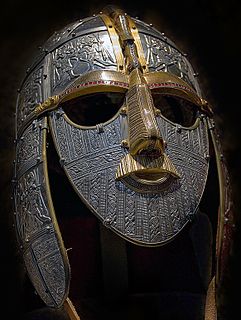 W
WMany different weapons were created and used in Anglo-Saxon England between the fifth and eleventh centuries. Spears, used for piercing and throwing, were the most common weapon. Other commonplace weapons included the sword, axe, and knife—bows and arrows, as well as slings, were not frequently used by the Anglo-Saxons. For defensive purposes, the shield was the most common item used by warriors, although mail and helmets were sometimes used.
 W
WThe armet is a type of helmet which was developed in the 15th century. It was extensively used in Italy, France, England, the Low Countries and Spain. It was distinguished by being the first helmet of its era to completely enclose the head while being compact and light enough to move with the wearer. Its use was essentially restricted to the fully armoured man-at-arms.
 W
WAn aventail or camail is a flexible curtain of mail attached to the skull of a helmet that extends to cover the throat, neck and shoulders. Part or all of the face, with spaces to allow vision, could also be covered.
 W
WA barbute is a visorless war helmet of 15th-century Italian design, often with a distinctive "T" shaped or "Y" shaped opening for the eyes and mouth.
 W
WThe bascinet – also bassinet, basinet, or bazineto – was a Medieval European open-faced military helmet. It evolved from a type of iron or steel skullcap, but had a more pointed apex to the skull, and it extended downwards at the rear and sides to afford protection for the neck. A mail curtain was usually attached to the lower edge of the helmet to protect the throat, neck and shoulders. A visor was often employed from ca. 1330 to protect the exposed face. Early in the fifteenth century, the camail began to be replaced by a plate metal gorget, giving rise to the so-called "great bascinet".
 W
WThe Benty Grange helmet is a boar-crested Anglo-Saxon helmet from the 7th century AD. It was excavated by Thomas Bateman in 1848 from a tumulus at the Benty Grange farm in Monyash in western Derbyshire. The grave had probably been looted by the time of Bateman's excavation, but still contained other high-status objects suggestive of a richly furnished burial, such as the fragmentary remains of a hanging bowl. The helmet is displayed at Sheffield's Weston Park Museum, which purchased it from Bateman's estate in 1893.
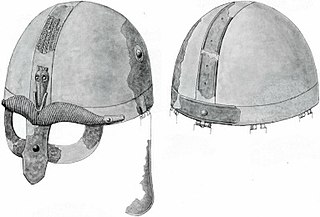 W
WThe Broe helmet is a decorated iron helmet from around the Vendel Period. Discovered around 1904 in a cremation grave in Broe, a farm on the Swedish island Gotland, it was located alongside other items including fragments of shields, weapons, bridles, and game pieces. Due to its extremely fragmented condition, only an incomplete reconstruction of the helmet is possible, but it appears to have been an example of the "crested helmets" that flourished in England and Scandinavia from the sixth through eleventh centuries.
 W
WA cervelliere is a hemispherical, close-fitting skull cap of steel or iron. It was worn as a helmet during the medieval period.
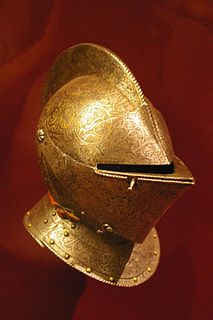 W
WThe close helmet or close helm was a military helmet worn by knights and other men-at-arms in the Late Medieval and Renaissance eras. It was also used by some heavily armoured, pistol-armed, cuirassiers into the mid 17th century. It was a fully enclosing helmet with a pivoting visor and integral bevor.
 W
WA combat helmet or battle helmet is a type of helmet, a piece of personal armor designed specifically to protect the head during combat.
 W
WThe Coppergate Helmet is an eighth-century Anglo-Saxon helmet found in York, England. It was discovered in May 1982 during excavations for the Jorvik Viking Centre at the bottom of a pit that is thought to have once been a well.
 W
WThe Coventry Sallet is a 15th-century helmet now on display at Herbert Art Gallery and Museum. English sallets have been considered both rare and important.
 W
WThe enclosed helmet, also termed a primitive great helm or early great helm, was a type of Western European helmet of the late 12th and early 13th century. It was the forerunner of the great helm.
 W
WThe falling buffe is 16th century armour for the throat and lower face. It evolved from the bevor and was composed of several lames, retained in place by spring catches, which could be lowered for better ventilation and vision. It was often attached to the otherwise open-faced helmet, the burgonet.
 W
WThe frog-mouth helm was a type of great helm, appearing from around 1400 and lasting into the first quarter of the 16th century. The helmet was primarily used by mounted knights for tournaments (jousting) rather than on the battlefield.
 W
WThe Gevninge helmet fragment is the dexter eyepiece of a helmet from the Viking Age or end of the Nordic Iron Age. It was found in 2000 during the excavation of a Viking farmstead in Gevninge, near Lejre, Denmark. The fragment is moulded from bronze and gilded, and consists of a stylised eyebrow with eyelashes above an oval opening. There are three holes at the top and bottom of the fragment to affix the eyepiece to a helmet. The fragment is significant as rare evidence of contemporaneous helmets, and also for its discovery in Gevninge, an outpost that is possibly connected to the Anglo-Saxon epic Beowulf. It has been in the collection of the Lejre Museum since its discovery, and has been exhibited internationally as part of a travelling exhibition on Vikings.
 W
WThe great helm or heaume, also called pot helm, bucket helm and barrel helm, is a helmet of the High Middle Ages which arose in the late twelfth century in the context of the Crusades and remained in use until the fourteenth century. The barreled style was used by knights in most European armies between about 1220 to 1350 AD and evolved into the frog-mouth helm to be primarily used during jousting contests.
 W
WThe Guilden Morden boar is a sixth- or seventh-century Anglo-Saxon copper alloy figure of a boar that may have once served as the crest of a helmet. It was found around 1864 or 1865 in a grave in Guilden Morden, a village in the eastern English county of Cambridgeshire. There the boar attended a skeleton with other objects, including a small earthenware bead with an incised pattern, although the boar is all that now remains. Herbert George Fordham, whose father originally discovered the boar, donated it to the British Museum in 1904; as of 2018 it was on view in room 41.
 W
WThe Hellvi helmet eyebrow is a decorative eyebrow from a Vendel Period helmet. It comprises two fragments; the arch is made of iron decorated with strips of silver, and terminates in a bronze animal head that was cast on. The eyebrow was donated to the Statens historiska museum in November 1880 along with several other objects, all said to be from a grave find in Gotland, Sweden.
 W
WThe Horncastle boar's head is an early seventh-century Anglo-Saxon ornament depicting a boar that probably was once part of the crest of a helmet. It was discovered in 2002 by a metal detectorist searching in the town of Horncastle, Lincolnshire. It was reported as found treasure and acquired for £15,000 by the City and County Museum, where it is on permanent display.
 W
WHorned helmets were worn by many people around the world. Headpieces mounted with animal horns or replicas were also worn, as in the Mesolithic Star Carr. These were probably used for religious ceremonial or ritual purposes. Horns tend to be impractical on a combat helmet. Much of the evidence for these helmets and headpieces comes from depictions rather than the items themselves.
 W
WKabuto is a type of helmet first used by ancient Japanese warriors, and in later periods, they became an important part of the traditional Japanese armour worn by the samurai class and their retainers in feudal Japan.
 W
WKatapu or Kalapu is a traditional war cap or helmet used by Dayaks of Borneo. Katapu Kaloi is a sea dayak war cap, made by sewing large fish scales on cap made from a bast-like material.
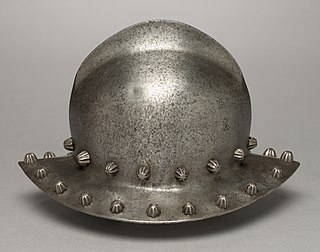 W
WA kettle hat, also known as a war hat, is a type of helmet made of iron or steel in the shape of a brimmed hat. There are many design variations. The only common element is a wide brim that afforded extra protection to the wearer. It gained its common English language name from its resemblance to a metal cooking pot. The kettle hat was common all over Medieval Europe. It was called Eisenhut in German and chapel de fer in French.
 W
WThe Lamellenhelm was a type of helmet used in Europe during the Early Middle Ages. Examples are characterized by caps made from overlapping lamellar scales, in addition to a brow plate, cheek guards, and camail. They are distinct from the contemporary spangenhelm and crested helmets also found in Europe; unlike those, which are influenced by Roman designs, Lamellenhelme display eastern influence and have primarily been found in southeastern Europe. They are mostly associated with the Avars of Pannonia and the Lombards of Italy.
 W
WThe Lokrume helmet fragment is a decorated eyebrow piece from a Swedish helmet dating from the Viking Age. Discovered in Lokrume, a small settlement on the island of Gotland, it was first published in 1907 and is in the collection of the Gotland Museum. It is made of iron, the surface of which is decorated with silver and niello that forms an interlaced pattern.
 W
WThe nasal helmet was a type of combat helmet characterised by the possession of a projecting bar covering the nose and thus protecting the centre of the face; it was of Western European origins and was used from the late 9th century to at least c. 1250.
 W
WPaseki is a helmet from Indonesia. It is used by the ethnic groups of eastern Indonesia, such as the Toraja and Minahasa of Sulawesi.
 W
WThe sallet was a combat helmet that replaced the bascinet in Italy, western and northern Europe and Hungary during the mid-15th century. In Italy, France and England the armet helmet was also popular, but in Germany the sallet became almost universal.
 W
WThe Shorwell helmet is an Anglo-Saxon helmet from the early to mid-sixth century AD found near Shorwell on the Isle of Wight in southern England. It was one of the grave goods of a high-status Anglo-Saxon warrior, and was found with other objects such as a pattern-welded sword and hanging bowl. One of only six known Anglo-Saxon helmets, alongside those from Benty Grange, Sutton Hoo, Coppergate, Wollaston, and Staffordshire, it is the sole example to derive from the continental Frankish style rather than the contemporaneous Northern "crested helmets" used in England and Scandinavia.
 W
WThe Spangenhelm was a popular medieval European combat helmet design of Late Antiquity and the Early Middle Ages.
 W
WThe Staffordshire helmet is an Anglo-Saxon helmet discovered in 2009 as part of the Staffordshire Hoard. It is part of the largest discovery of contemporary gold and silver metalwork in Britain, which contained more than 4,000 precious fragments, approximately a third of which came from a single high-status helmet. Following those found at Benty Grange, Sutton Hoo, Coppergate, Wollaston, and Shorwell, it is only the sixth known Anglo-Saxon helmet.
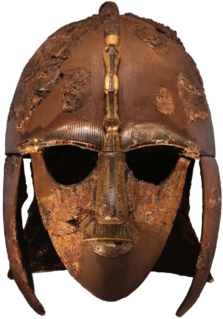 W
WThe Sutton Hoo helmet is a decorated and ornate Anglo-Saxon helmet found during a 1939 excavation of the Sutton Hoo ship-burial. It was buried around 625 and is widely believed to have belonged to King Rædwald of East Anglia; its elaborate decoration may have given it a secondary function akin to a crown. The helmet was both a functional piece of armour that would have offered considerable protection if ever used in warfare, and a decorative, prestigious piece of extravagant metalwork. It is described as "the most iconic object" from "one of the most spectacular archaeological discoveries ever made," and perhaps the most important known Anglo-Saxon artefact.
 W
WThe Takula Tofao is a traditional battle helmet from Nias Island, Indonesia.
 W
WThe Tjele helmet fragment is a Viking Age fragment of iron and bronze, originally comprising the eyebrows and noseguard of a helmet. It was discovered in 1850 with a large assortment of smith's tools in Denmark, and though the find was sent to the National Museum of Denmark, for 134 years the fragment was mistaken for a saddle mount. In 1984 it was properly identified by an assistant keeper at the museum as the remainder of one of only five known helmets from the Viking era.
 W
WA Turban helmet is a variety of Turkish helmet specifically known for its bulbous shape and fluting that imitates the folds of a turban. Turban helmets originated in Ottoman Turkey, primarily used by warriors and some external attics.